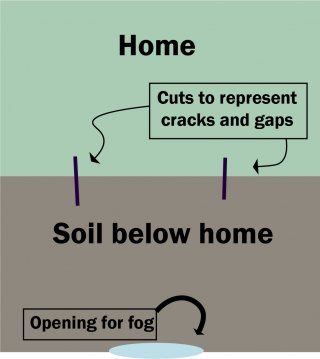RadTown Radon Activity 2: Radon Vacuum
In the Radon Vacuum activity, students will better understand how homes and buildings draw radon into basements, pipes, and lower floors. Students will use critical thinking skills to create hypotheses, and test them using an experiment. This activity is intended for middle and high school students.
- Objectives
- Next Generation Science Standards
- Materials and Resources
- Time
- Vocabulary
- Directions
- Common Core State Standards
- PDFs of Worksheets and Classroom Aids
Objectives
Students will:
- Hypothesize how their home can act like a vacuum, drawing radon in.
- Conduct an experiment and demonstrate how homes act like a vacuum.
- Hypothesize or demonstrate ways to prevent radon from entering the home or ways to vent the radon out of the home.
Next Generation Science Standards
The concepts in this activity can be used to support the following science standards:
- ESS3. Earth and Human Activity
- ETS1. Engineering Design
Materials and Resources
Each italicized document title can be found at the bottom of this page, and is available for printing and distribution.
- Radon: Teacher Background Information
- Vocabulary Materials
- How Radon Travels Image (display using a computer and projector)
- Radon Vacuum Worksheet (one per student, pair or group)
- Option A for Step 5(per pair or group):
- Empty plastic bottle, 20-ounce or 2-liter
- Straws (one per student)
- Clay to seal opening of 2-liter bottles
- Water
- A container to set under the bottle and collect water
- Option B for Step 5 (per pair or group):
- Two shoe boxes or small boxes
- Scissors
- Masking or duct tape
- Plastic tubing or paper towel tubes
- Fog machine or materials for a do-it-yourself fog machine with glycerin or dry ice
PDFs of Worksheets and Classroom Aids
Time
45-60 minutes, not including optional activities or extensions.
Vocabulary
- Ionizing radiation
- Radiation
- Radon
- Uranium
Directions
- Start with a vocabulary activity if students are not familiar with radon and the terms used in this activity.
- Show the How Radon Travels image and distribute the Radon Vacuum Worksheet to students.
- Ask students to hypothesize in question 1 how their home can act like a vacuum, drawing radon in, and the ways in which radon can enter their home. Answers may vary; however, the air pressure inside homes is usually lower than pressure in the soil around foundations. Because of this difference in pressure, buildings acts like a vacuum, drawing radon in through cracks in the foundation and other openings.
- Explain that students will have the opportunity to conduct an experiment and demonstrate how homes act like a vacuum because of lower pressure in the house drawing in radon. Conversely, the higher pressure of the soil around a home’s foundation will force the radon inside of the home where the pressure is lower.
Select an activity for students to complete and provide them with directions.

- Option A: Direct students to fill the plastic bottle one half to two-thirds full and set the bottle in the container. Insert a straw into the mouth of the bottle and seal the mouth of the bottle, around the straw, with clay. Direct students to blow hard and then step back. Student should see liquid move as the pressure changes in the bottle when they blow into the straw. NOTE: This activity can be conducted outside.
- Option B: Direct students to secure two boxes together. The bottom box will represent soil below your home’s foundation and should be sealed shut. The top box will represent your home and can be open on one side so students can see in. Where the two boxes are secured together, make several cuts to represent cracks and gaps that might exist in floors, in walls and around service pipes. Cut a small hole in the bottom box so that fog can be pumped into the bottom box. Students should see the fog coming through the cracks and collect in the “home.”
- Ask students to share their observations and conclusions. Students should recognize that the higher pressure will force radon through cracks and crevices and into homes and buildings (Option A) or that radon can enter homes through cracks and gaps (Option B).
- Ask students to investigate and demonstrate ways to prevent radon from entering the home or ways to vent the radon out of the home. With Option A, students can cut a hole or window in the bottle to show how ventilation improves air pressure inside the bottle. With Option B, students can seal up cracks with tape and use plastic tubing or paper towel tubes to take radon directly from the bottom box (soil below the home) straight up and out so that it never goes into the home. Other options include cutting out/opening windows in the home and using tubing, vents or exhaust fans to take the radon out of the home.
- Conclude by having students share at least one thing they have learned about radon.
- Optional activities or extensions:
- Have students examine how radon reduction systems work and their costs.
- Invite a radon professional to speak about radon in the area, the importance of testing homes and ways to reduce radon levels.
- Have students create posters for the National Radon Poster Contest
The concepts in the Radon Vacuum activity align with the following:
CCSS English Language Arts Standards for Literacy in History/Social Studies, Science, & Technical Subjects
- CCSS.ELA-LITERACY.SL.6-12.4 Presentation of Knowledge and Ideas
- CCSS.ELA-LITERACY.RST.6-12.7 Integration of Knowledge and Ideas
- CCSS.ELA-LITERACY.WHST.6-12.1 Text Types and Purposes

